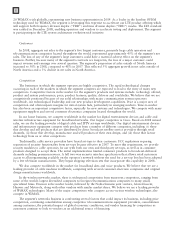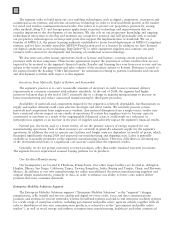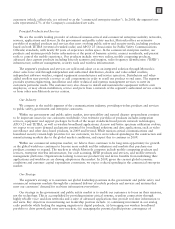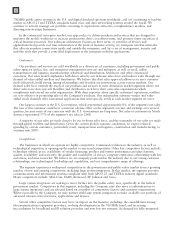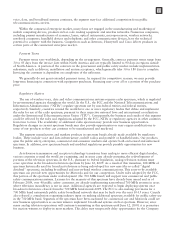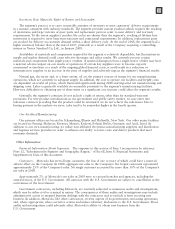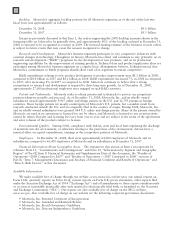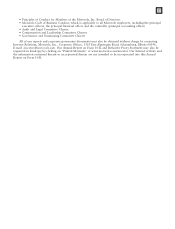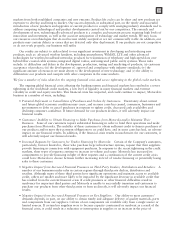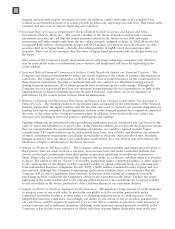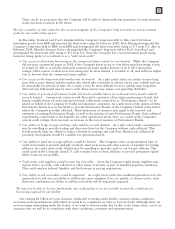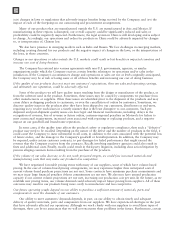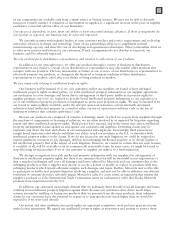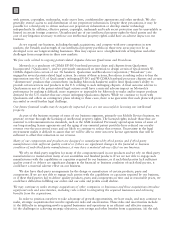Motorola 2008 Annual Report Download - page 26
Download and view the complete annual report
Please find page 26 of the 2008 Motorola annual report below. You can navigate through the pages in the report by either clicking on the pages listed below, or by using the keyword search tool below to find specific information within the annual report.
Item 1A: Risk Factors
We wish to caution the reader that the following important risk factors, and those risk factors described
elsewhere in this report or our other Securities and Exchange Commission filings, could cause our actual results
to differ materially from those stated in forward-looking statements contained in this document and elsewhere.
These risks are not presented in order of importance or probability of occurrence.
We have had substantial operating losses in 2008 and 2007 and may continue to incur losses as we reposition our
Mobile Devices business.
In 2008 and 2007, Motorola had substantial operating losses as a result of the financial performance of our
Mobile Devices business. While we have plans in place intended to improve the performance of this business, we
cannot be certain that we will be successful or that we will be profitable in 2009.
The wireless mobile handset market experienced slowing growth in 2008 and the market is expected to decline in
2009 which could negatively impact transition plans for our Mobile Devices business.
In 2009, worldwide wireless handset industry unit shipments are expected to decline by approximately 10%.
This would be the first annual decline in industry handset unit shipments since 2001. A declining mobile handset
market may make it more difficult to improve our business, due to excess manufacturing capacity, increased price
competition and other market factors.
We have lost significant market share in our Mobile Devices businesses and such loss has negatively impacted our
performance and may continue to negatively impact our financial results.
Our share of the worldwide wireless handset market has declined significantly in the last two years, from
approximately 22% in 2006, to 14% in 2007, to 8% in 2008. While we reduced our costs during this period of
time, these market share declines and resulting volume reductions have had an adverse effect on our results of
operations. If market share in our Mobile Devices business continues to decline, it will adversely impact our
financial results.
The uncertainty of current economic and political conditions makes budgeting and forecasting difficult and may
reduce demand for our products.
Current conditions in the domestic and world economies are very uncertain. The global financial crisis, as well
as ongoing political conflicts in the Middle East and elsewhere, have created many economic and political
uncertainties that have impacted worldwide markets. As a result, it is difficult to estimate changes in various parts
of the world economy, including the markets in which we participate. Because all components of our budgeting
and forecasting are dependent upon estimates in the markets we serve and demand for our products, the prevailing
economic uncertainties render estimates of future income and expenditures difficult.
We have manufacturing operations and engineering resources in Israel that could be disrupted as a result of
hostilities in the region. We also sell our products and services throughout the Middle East and demand for our
products and services could be adversely impacted by hostilities in this region.
The potential for future terrorist attacks, increased global conflicts and the escalation of existing conflicts and
public health issues has created worldwide uncertainties that have negatively impacted, and may continue to
negatively impact, demand for certain of our products.
We operate in highly competitive markets and our financial results will be affected if we are not able to compete
effectively.
The markets for our products are highly competitive with respect to, among other factors: pricing, product
features, product and service quality, and the time required to introduce new products and services. We are
constantly exposed to the risk that our competitors may implement new technologies before we do, or may offer
lower prices, additional products or services or other incentives that we cannot or will not offer. We can give no
assurances that we will be able to compete successfully against existing or future competitors.
Our success depends in part on our timely introduction of new products and technologies and our results can be
impacted by the effectiveness of our significant investments in new products and technologies.
The markets for our products are characterized by rapidly changing technologies, frequent new product
introductions, short product life cycles and evolving industry standards. We face intense competition in these
18


